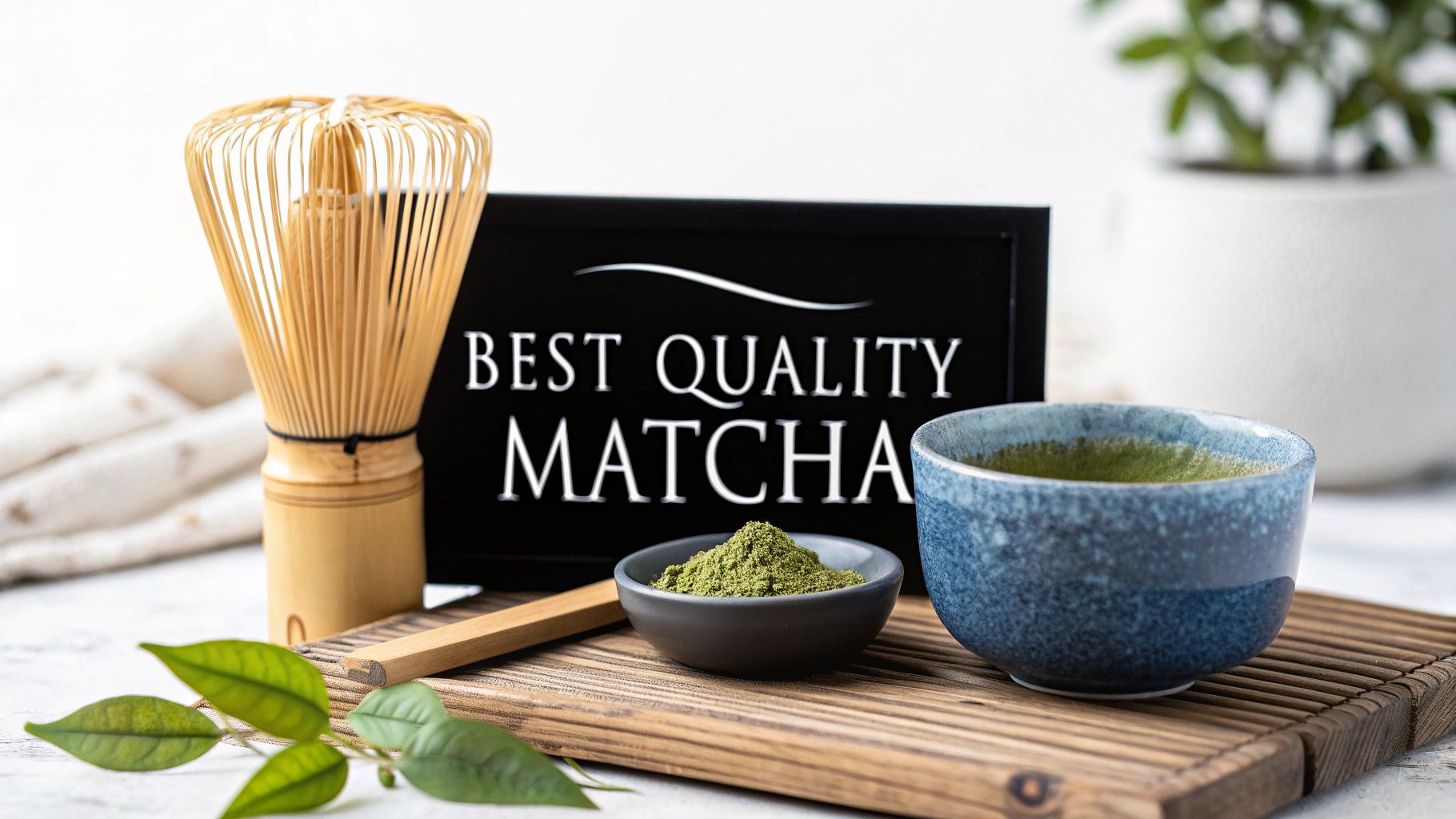When you’re searching for the best quality matcha, it's about much more than just the price tag. It’s a full sensory experience—a combination of vibrant colour, a delicate texture, and that deep, savoury flavour known as 'umami'.
True quality is the result of an incredibly careful process, from shading young tea leaves for weeks to grinding them with traditional stone mills. Understanding this journey is what separates an authentic, uplifting ritual from a cup of bitter, dull-tasting green powder. It's the difference between a functional, energising habit and a disappointing purchase.
What Defines the Best Quality Matcha
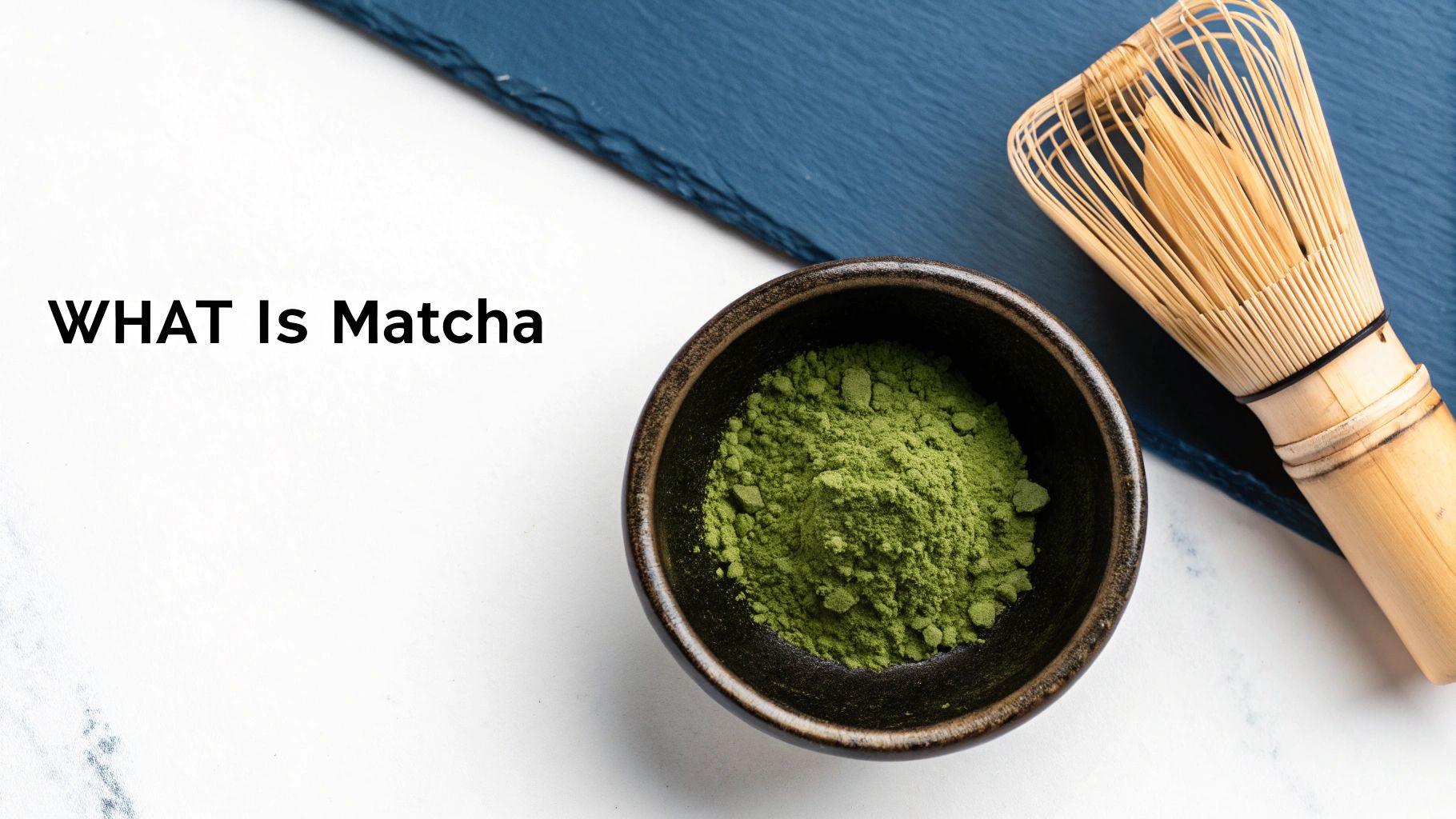
Diving into the world of matcha can feel a bit daunting. There are so many brands and grades out there, all promising an authentic Japanese experience. But the truth is, the very best matcha always shares a few key, non-negotiable characteristics. Learning to spot these is your first step to choosing a powder that truly delivers on flavour and health benefits.
It helps to think of it like choosing fresh fruit or vegetables at the market. You naturally look for bright colours, a fresh smell, and a good texture as signs of quality. The same logic applies to matcha. The most sought-after powders are born from meticulous cultivation and processing, and you can train your senses to spot them.
From Ancient Ritual to Modern Wellness
For centuries, matcha has been the heart of the Japanese tea ceremony—a mindful practice built around purity, harmony, and tranquillity. This tradition demands the absolute highest standard of tea, and those same principles are what define top-tier matcha today.
It all starts weeks before the harvest, when the tea plants are carefully covered to shade them from direct sun. This crucial step boosts the production of chlorophyll (hello, vibrant green!) and L-Theanine, an amino acid that gives matcha its signature umami taste and its unique ability to foster a calm, focused state of mind.
This painstaking process creates a matcha that is:
- Visually Striking: A brilliant, almost luminous, jade green.
- Aromatically Complex: A fresh, sweet, and slightly grassy fragrance.
- Rich in Flavour: A beautiful balance of savoury umami with a hint of natural sweetness.
The real giveaway is in the balance of flavours. Premium matcha, like Amatsu's Pure for traditional sipping or Radiance for a beauty boost, feels smooth and creamy in the mouth, leaving a pleasant, lingering sweetness. It’s completely free from the harsh, astringent bitterness you often find in lower-grade powders.
High-Quality vs Low-Quality Matcha at a Glance
To make it even simpler, here’s a quick cheat sheet. Use this table to instantly tell if you're looking at the good stuff or a poor imitation.
| Characteristic | Best Quality Matcha (e.g., Amatsu) | Low-Quality Matcha |
|---|---|---|
| Colour | Vibrant, electric jade green. | Dull, yellowish, or brownish-green. |
| Texture | Silky, fine powder, similar to talc. | Coarse, gritty, and clumpy. |
| Aroma | Fresh, sweet, and vegetal. | Stale, dusty, or hay-like smell. |
| Taste | Smooth, creamy, with rich umami and a sweet finish. | Bitter, astringent, and flat. |
| Foam (Crema) | Whips into a thick, frothy, stable crema. | Produces thin, large bubbles that disappear quickly. |
Ultimately, a quick glance at these five points can save you from a disappointing cup of tea.
Key Indicators of Excellence
At the end of the day, finding superior matcha just comes down to knowing what to look for. When you choose a ceremonial grade product, you're getting tea made from only the youngest, most tender leaves from the year's first harvest. These precious leaves are then stone-ground into an impossibly fine powder.
This commitment to quality makes all the difference. By learning to recognise these simple signs, you can confidently navigate the market and find a matcha that is genuinely smooth, flavourful, and revitalising with every single sip.
Decoding Ceremonial and Culinary Matcha Grades
Stepping into the world of matcha can feel a bit overwhelming at first, but it really boils down to one key distinction: ceremonial versus culinary grade. Getting this right isn't about being a tea snob; it's about making sure you have the right tool for the job. Think of it like wine – you wouldn't use a prized vintage Bordeaux in a stew, and you wouldn't serve a robust cooking wine to a guest. Each has its place, and matcha is no different.
The grade of matcha tells you a story about when the tea leaves were picked, what they'll taste like, and how they're best used. Picking the wrong one can leave you with a bitter, disappointing cup. But when you get it right? That's when you discover that sublime moment of calm and focus that makes matcha so special.
What Is Ceremonial Grade Matcha?
This is the crème de la crème of the matcha world. Ceremonial grade is crafted purely for drinking and savouring. It's made from the youngest, most delicate leaves, hand-picked during the first harvest of the year (known as ichibancha). These early leaves are packed with L-Theanine, an amino acid that gives the matcha its signature smooth, complex flavour, full of deep umami and a subtle, natural sweetness.
This is the very matcha used in traditional Japanese tea ceremonies, where the entire focus is on the mindful preparation and pure taste of the tea. Its texture is incredibly fine and silky, allowing it to froth up beautifully into a vibrant green liquid when whisked with hot water, with absolutely no grittiness. If you're after that authentic sipping experience, a high-quality ceremonial blend is what you need. All Amatsu Matcha blends, from Pure to our functional Shrooms and Strength varieties, use only ceremonial grade powder to ensure the best taste and benefits.
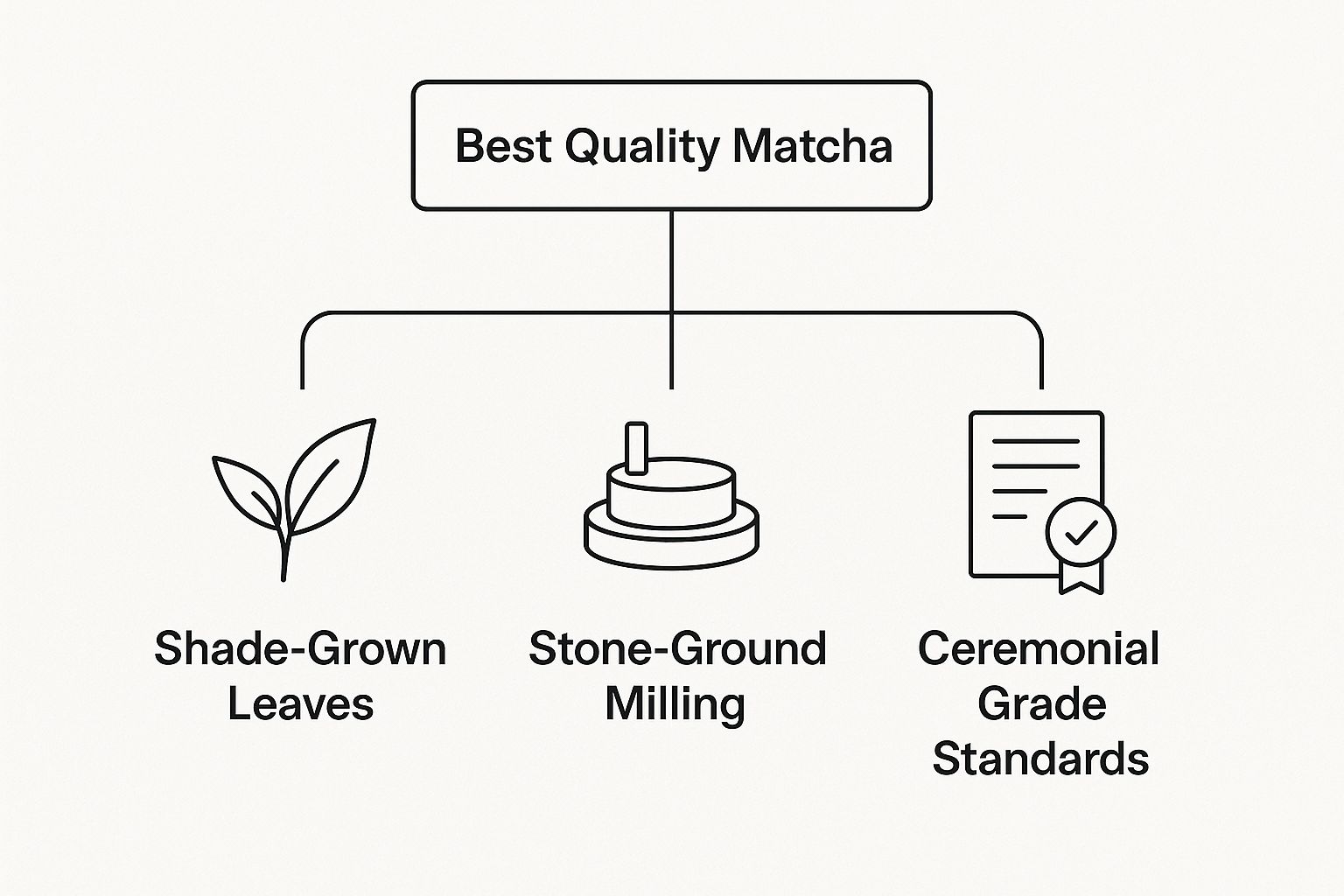
As you can see, true ceremonial quality isn't just a label; it's the result of incredibly strict cultivation and processing from start to finish.
What Is Culinary Grade Matcha?
Culinary grade matcha, as the name suggests, is your go-to for the kitchen. It’s generally made from leaves picked later in the season during the second or third harvests. Because these leaves have had more sun exposure, they develop a much bolder, stronger flavour with a more noticeable bitterness. This isn't a bad thing—it's exactly what you want when mixing matcha with other ingredients.
While you wouldn't want to drink it straight with water, its robust character is perfect for:
- Smoothies and Shakes: It cuts through other flavours to give you that distinct matcha taste and an antioxidant boost.
- Baking: Its strong profile holds its own in cakes, cookies, and pastries.
- Lattes with Sweeteners: The bold flavour stands up beautifully to milk and syrups.
- Creative Recipes: Think sauces, marinades, or even savoury dishes where you want a pop of earthy flavour.
Don't make the mistake of thinking "culinary" means "low quality." A good culinary matcha is a quality product; it's just been produced with a different purpose in mind. It’s a workhorse ingredient, not a delicate solo performer.
Choosing the Right Grade for Your Needs
The main takeaway here is simple: match the grade to what you're doing. Using a delicate and expensive ceremonial matcha in your baking is a waste of its nuanced flavour. On the other hand, trying to sip a culinary grade matcha prepared with just water will likely be a harsh, bitter experience.
The distinction is simple, and it's something more and more people are starting to understand. Across the UK, for instance, we're seeing a huge rise in demand for high-quality matcha as health-conscious consumers look for natural, functional foods. Shops are increasingly stocking both ceremonial and culinary options to meet this growing interest.
Ultimately, having both on hand is the best way to cover all your bases. Use a ceremonial grade for your quiet morning ritual and grab the culinary grade when you feel like getting creative in the kitchen. To really get into the nitty-gritty of it all, you might want to check out our complete guide on matcha tea grades.
Why Japanese Origin and Terroir Matter
Think of a fine wine. Its unique taste tells a story about the vineyard it came from—the soil, the climate, the very air it grew in. The best quality matcha is no different. This concept, known as terroir, is the secret behind why true, premium matcha can only come from Japan.
Japan's unique geography, coupled with centuries of perfecting cultivation, creates an environment that simply can’t be duplicated elsewhere. When you choose authentic Japanese matcha, you're not just buying a green powder; you're tasting a legacy of agricultural artistry. This connection to the land is the very foundation of quality.
The Prestigious Terroirs of Japan
Just as Bordeaux is to wine, certain regions in Japan are legendary for producing the world’s finest matcha. Each area has its own signature profile, a direct result of its unique terroir.
-
Uji (Kyoto Prefecture): This is the historic heartland of matcha, and for good reason. Uji has the perfect storm of conditions: mineral-rich soils, a mild climate, and persistent river mists that naturally shield the tea leaves. The result is a matcha celebrated for its deep, savoury umami and brilliant emerald colour—the gold standard for ceremonial grades.
-
Kagoshima (Kyushu Island): As Japan’s second-largest tea producer, Kagoshima benefits from a warmer climate and fertile volcanic soil. This terroir produces a bolder, full-bodied matcha with a wonderfully refreshing and less bitter finish, making it a star in both traditional ceremonies and high-end lattes.
Choosing matcha from these prestigious regions, like the Uji-sourced leaves in Amatsu Matcha, is your assurance of quality. These are places where generations of farmers have passed down specialised knowledge, a history of excellence you can taste in every sip.
You wouldn't look for authentic Champagne outside the Champagne region of France, would you? The same principle applies here. True matcha quality is tied to its Japanese roots, where the art of tea has been perfected over 800 years.
The Crucial Role of Shade-Growing
Beyond the region, the most vital cultivation step for premium matcha is shade-growing. For about three to four weeks before the spring harvest, the tea fields are carefully covered with traditional bamboo mats or black cloths. This isn’t just for looks; it’s a meticulous process that transforms the tea leaves.
Blocking the sunlight forces the plants to overproduce chlorophyll, which is what gives high-grade matcha its stunning, vibrant green hue. Even more importantly, this stress boosts the concentration of L-theanine, the amino acid responsible for that signature calming focus and the deep, savoury umami flavour. This is what separates the smooth, complex taste of the best quality matcha from the bitterness found in common green tea.
This is a labour-intensive practice reserved only for the highest grades. The synergy between a world-class terroir and the demanding technique of shade-growing is what creates the nuanced flavour and potent benefits matcha is famous for. You can learn more about this rich history by exploring our guide to authentic Japanese matcha green tea powder. Ultimately, origin isn't just a detail on a label; it’s a guarantee of authenticity, tradition, and unparalleled quality.
A Sensory Guide to Spotting Premium Matcha
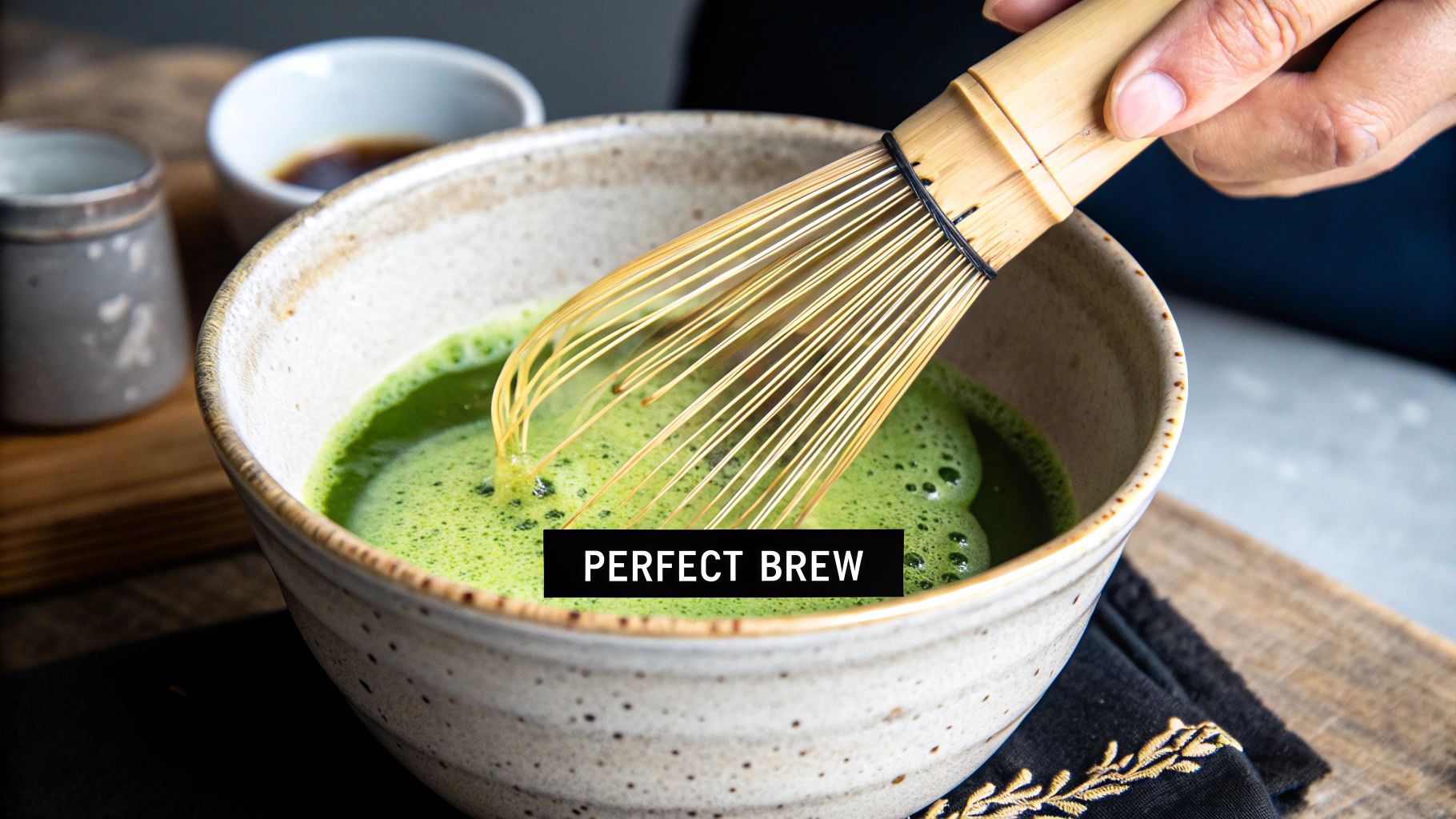
Forget about grades and origins for a moment. Your own senses are your best allies when it comes to finding exceptional matcha. You don't need to be a tea master to tell the good stuff from the bad; you just need to know the signs. It’s a bit like developing a palate for fine wine or dark chocolate—once you know what you’re looking for, the quality becomes obvious.
This sensory guide will help you become a more confident and discerning matcha buyer. By paying attention to what you see, smell, feel, and taste, you'll soon be able to spot a vibrant, premium powder and sidestep the dull, disappointing imitations.
Let's break down the four key sensory cues that tell the true story of your matcha.
The Visual Test: Colour and Vibrancy
The first thing that hits you is the colour, and it tells you almost everything you need to know. The very best matcha boasts a brilliant, almost electric, jade-green hue. This isn't just for show. That vibrant colour comes directly from the careful shade-growing process, which floods the tea leaves with chlorophyll.
A dull, swampy, or yellowish-green powder is an immediate red flag. This usually means the leaves were picked later in the season, weren't shaded properly, or have been damaged by oxygen from poor storage.
Think of it like comparing a bunch of fresh, deep-green spinach to wilted lettuce. The lively colour of the spinach screams freshness and nutrients, while the pale, sad colour of the lettuce tells you it's well past its best. The same logic applies perfectly to matcha.
The Aromatic Experience: Smell
Next up, trust your nose. Before a single drop of water is added, the aroma of the dry powder should be captivating. When you pop the lid on a tin of high-quality matcha, you should get a complex and inviting fragrance that’s sweet, fresh, and distinctly vegetal, all at once.
This wonderful aroma is the signature of young, first-harvest leaves packed with amino acids, especially L-Theanine. It might bring to mind freshly cut grass with a subtle, sweet undertone—a sure sign of freshness and careful handling.
In stark contrast, low-grade matcha often smells flat, dusty, or a bit like hay. If it smells stale or musty, it's probably old or has been poorly packaged. No smell at all is just as bad.
The Tactile Cue: Texture
How the matcha feels between your fingers is another critical clue, telling you all about how it was milled. The best quality matcha is ground on traditional granite stone mills. It’s a slow, painstaking process that creates a powder so fine—with particles measuring just 5-10 microns—that it feels like silk or talc.
This incredibly fine texture is what allows the matcha to suspend beautifully in water, creating that smooth, creamy froth without any graininess. A coarser, gritty feel suggests it was ground with industrial machines, which often generate heat that damages the delicate powder. You can find out more about the standards that define this in our guide on what makes ceremonial grade matcha special.
The Final Verdict: Taste and Finish
Of course, the ultimate test is in the tasting. A properly whisked bowl of premium matcha should be smooth and full-bodied, with a beautiful balance of savoury and sweet notes. The first sip should reveal a deep, rich umami flavour, which then gives way to a subtle, lingering sweetness that stays with you.
This complex, velvety taste is exactly what ceremonial matcha is celebrated for. It should feel creamy in your mouth, never harsh or chalky. If you're hit with an overpowering, astringent bitterness, you're dealing with a low-grade product. A touch of bitterness is normal for green tea, but in great matcha, it’s just a background note, not the main performance.
To pull it all together, here’s a quick checklist you can use to judge any matcha that comes your way. Keep these sensory cues in mind, and you'll always be able to pick out a winner.
Sensory Checklist for Judging Matcha Quality
| Sensory Cue | Indicator of High Quality | Indicator of Low Quality |
|---|---|---|
| Sight | Vibrant, electric jade green. | Dull, swampy green, or yellowish/brownish tones. |
| Touch | Silky, fine, talc-like texture. Clumps easily. | Coarse, gritty, or sandy feel. |
| Smell | Fresh, sweet, vegetal aroma with grassy notes. | Flat, dusty, hay-like, or musty smell. Little to no aroma. |
| Taste | Smooth, creamy, rich umami flavour with a sweet finish. | Overwhelmingly bitter, astringent, or chalky taste. |
By training your senses to recognise these key differences, you're no longer just buying matcha—you're actively curating your own tea experience, ensuring every bowl is a delight.
How Processing and Packaging Preserve Quality
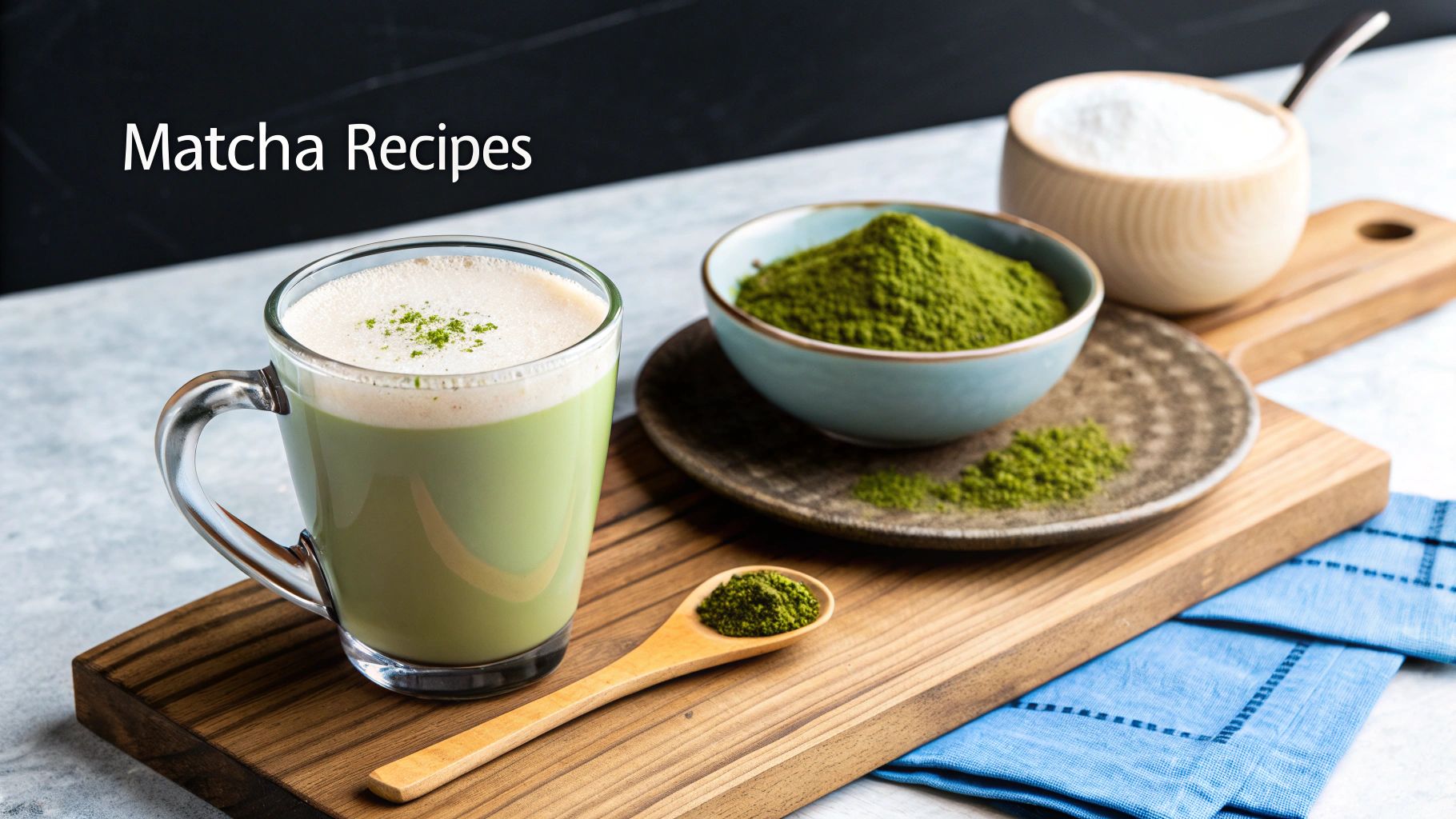
The journey from a fresh tea leaf in a Uji field to the fine powder in your cup is a race against time. Every step is meticulously designed to lock in the freshness, delicate flavour, and powerful nutrients that define the best quality matcha. This is where the real expertise lies, separating an average powder from an exceptional one.
It all starts the moment the leaves are picked. Unlike other teas, matcha leaves aren’t left to wither or oxidise. Instead, they’re rushed to be steamed, often within just a few hours of being harvested.
This steaming is a critical step. Think of it like blanching vegetables to keep their vibrant colour; it instantly stops the enzymes that would cause oxidation. This process is what preserves the leaves’ brilliant green hue and locks in their rich supply of antioxidants and amino acids.
The Art of Stone-Grinding
After the leaves are steamed and dried, they become what’s known as tencha. They are then carefully de-stemmed and de-veined, so only the purest, most tender parts of the leaf remain. Now comes the stage that truly defines the final texture and flavour: the grinding.
Authentic, ceremonial grade matcha is always ground using traditional granite stone mills. It’s a deliberately slow, almost meditative process. A single stone mill might take a full hour just to produce 30-40 grams of matcha powder.
But why be so painstaking? Speed creates heat, and heat is the enemy of delicate matcha. Industrial grinders can actually burn the leaves, introducing a bitter, scorched taste and destroying those subtle sweet notes. The cool, methodical friction from stone mills ensures the powder stays pristine, resulting in its signature silky, talc-like texture.
The incredibly fine powder from stone mills is what makes a smooth, creamy brew possible. It allows the matcha to suspend beautifully in water, creating that desirable thick froth instead of sinking to the bottom as a gritty sediment.
Of course, knowing how to prepare matcha tea correctly is key to enjoying this fine powder. Our guide offers simple steps to help you whisk up the perfect bowl every time.
Why Packaging Is a Final Guardian of Quality
Once ground, matcha becomes extremely fragile. It has three natural enemies that will quickly degrade its quality:
- Light: UV rays bleach the chlorophyll, turning that vibrant green into a dull, yellowish-brown.
- Air: Oxygen causes oxidation, which makes the matcha taste flat and stale, robbing it of its fresh aroma.
- Heat: Warm temperatures speed up the degradation process, ruining both the flavour and nutritional benefits.
This is exactly why you'll never find top-tier matcha in a clear glass jar or a simple paper bag. Premium brands like Amatsu Matcha understand this, which is why we use airtight, opaque tins for all our blends—from Pure to Radiance. This packaging acts as a final barrier, ensuring the powder you open is just as fresh and vibrant as the day it was milled in Japan.
This dedication to quality is something consumers are increasingly looking for. Here in the UK, there's a growing demand for ethically sourced and properly produced matcha, especially the premium, shade-grown powders from Japan that are perfect for everything from traditional ceremonies to modern lattes.
Brewing a Perfect Cup to Unlock its Full Flavour
You’ve gone to the trouble of finding a fantastic, high-quality matcha, so the final step is preparing it in a way that lets it truly shine. Even the best matcha in the world can be ruined by simple mistakes, and the most common culprit is using water that’s far too hot.
Boiling water will instantly scorch the delicate powder. When that happens, all those complex, beautiful flavours are destroyed, leaving you with a bitter, disappointing drink. Think of it like cooking a delicate piece of fish; you wouldn't blast it on the highest heat. Matcha needs that same gentle touch to coax out its sublime, nuanced character.
Mastering just a few key details will guarantee you get a smooth, frothy, and delicious cup every single time, truly honouring the quality you've invested in.
The Traditional Method for Pure Matcha
For a classic experience, especially when you're working with a top-tier ceremonial blend like Amatsu Pure, the traditional method is unbeatable. Using a bamboo whisk (a chasen) is key because it aerates the matcha perfectly, creating that signature creamy foam.
- Sift Your Matcha: First, use a small sieve to sift 1-2 teaspoons (approx. 2g) of matcha powder into a wide bowl, known as a chawan. This is a non-negotiable step—it breaks up any clumps and is the secret to a silky-smooth texture.
- Add Hot Water: Gently pour about 60-70ml of hot, but not boiling, water over the powder. The sweet spot is right around 80°C (175°F).
- Whisk Vigorously: Now, take your chasen and whisk rapidly in a "W" or "M" motion, not in circles. Keep this up for about 15-20 seconds until you see a thick, uniform layer of tiny bubbles form on the surface.
This technique isn’t just for show; it creates a beautiful suspension of the powder in the water. The result is a full-bodied, creamy mouthfeel that lets you taste every single note of umami and sweetness the tea has to offer.
A Modern Twist: The Perfect Matcha Latte
For a richer, creamier drink, nothing beats a well-made matcha latte. This approach is perfect for functional blends like Amatsu Strength for pre-workout energy or Amatsu Shrooms for enhanced focus, where the powder can be beautifully combined with other nourishing ingredients.
- Create a Matcha Shot: Start by following steps 1 and 2 from the traditional method, but use a little less water (around 30ml) to create a concentrated, smooth paste.
- Froth Your Milk: Gently heat and froth around 180-200ml of your favourite milk. Oat and almond milk both work beautifully here, complementing the matcha's flavour without overpowering it.
- Combine and Enjoy: Pour the frothed milk over your matcha shot. You can add a touch of natural sweetener if you like, but with ceremonial grade matcha, you might find you don’t need it. Its natural sweetness really comes through on its own.
By simply paying attention to these details—sifting the powder, minding the water temperature, and whisking properly—you guarantee a perfect cup. It’s how you’ll fully appreciate the vibrant colour, rich aroma, and exceptional flavour of your matcha with every single sip.
Got Questions About Matcha? We've Got Answers
Stepping into the world of matcha often sparks a bit of curiosity. It's completely natural to have questions when you're looking for the absolute best. Here are some straightforward answers to the things people ask us most, so you can feel confident in your choice and your daily ritual.
How Should I Store My Matcha?
Once you open a tin of matcha, its biggest foes are air, light, and heat. To keep that stunning colour, delicate flavour, and all its powerful nutrients locked in, you have to store it properly.
It's simple, really: keep your matcha in its original airtight tin and pop it in the fridge. This little step is your best defence against oxidation, ensuring it stays as fresh as the day it was ground.
Is Matcha Really Healthier Than Green Tea?
Yes, and by a long shot. When you brew a cup of regular green tea, you’re basically just drinking leaf-infused water. With matcha, you consume the entire leaf, which has been carefully ground into a fine powder.
This means you get 100% of the nutrients. We're talking a massive dose of antioxidants like EGCG, essential vitamins, and the wonderfully calming amino acid, L-Theanine. To get the full picture, take a look at our deep dive into the many matcha health benefits.
Top-tier matcha gives you something quite special: a sense of calm alertness and a wealth of nutrition. It’s a brilliant way to get sustained energy without the jitters you might get from coffee. This is why our Shrooms blend, combining matcha with Lion's Mane and Cordyceps, is so effective for focus.
Why Is Everyone in the UK Suddenly Drinking Matcha?
The UK has well and truly caught the matcha bug! This boom is mostly down to a big shift towards healthier living. People are actively looking for natural drinks that do more than just quench their thirst—they want functional benefits.
Matcha fits the bill perfectly, especially with its antioxidant levels, which are said to be up to 137 times that of regular green tea. It’s a perfect match for anyone wanting clean, effective products to support their wellness goals. You can read more about these market trends and consumer demand.
Can I Drink Matcha Every Day?
Absolutely! Making a daily bowl of high-quality matcha part of your routine is a fantastic habit. It’s a wonderful way to support your energy levels, mental focus, and overall sense of well-being throughout the day.
For most people, a single serving of one to two grams is the ideal amount to reap all the rewards without any downsides. It's a simple ritual that pays huge dividends for your mind and body.
Ready to feel the difference that real quality makes? Amatsu Matcha offers a carefully chosen range of ceremonial grade blends, all sourced from Uji, Japan. From the classic simplicity of Pure to the focused benefits of Radiance, Shrooms, and Strength, there's a perfect blend to elevate your daily ritual.
Read more
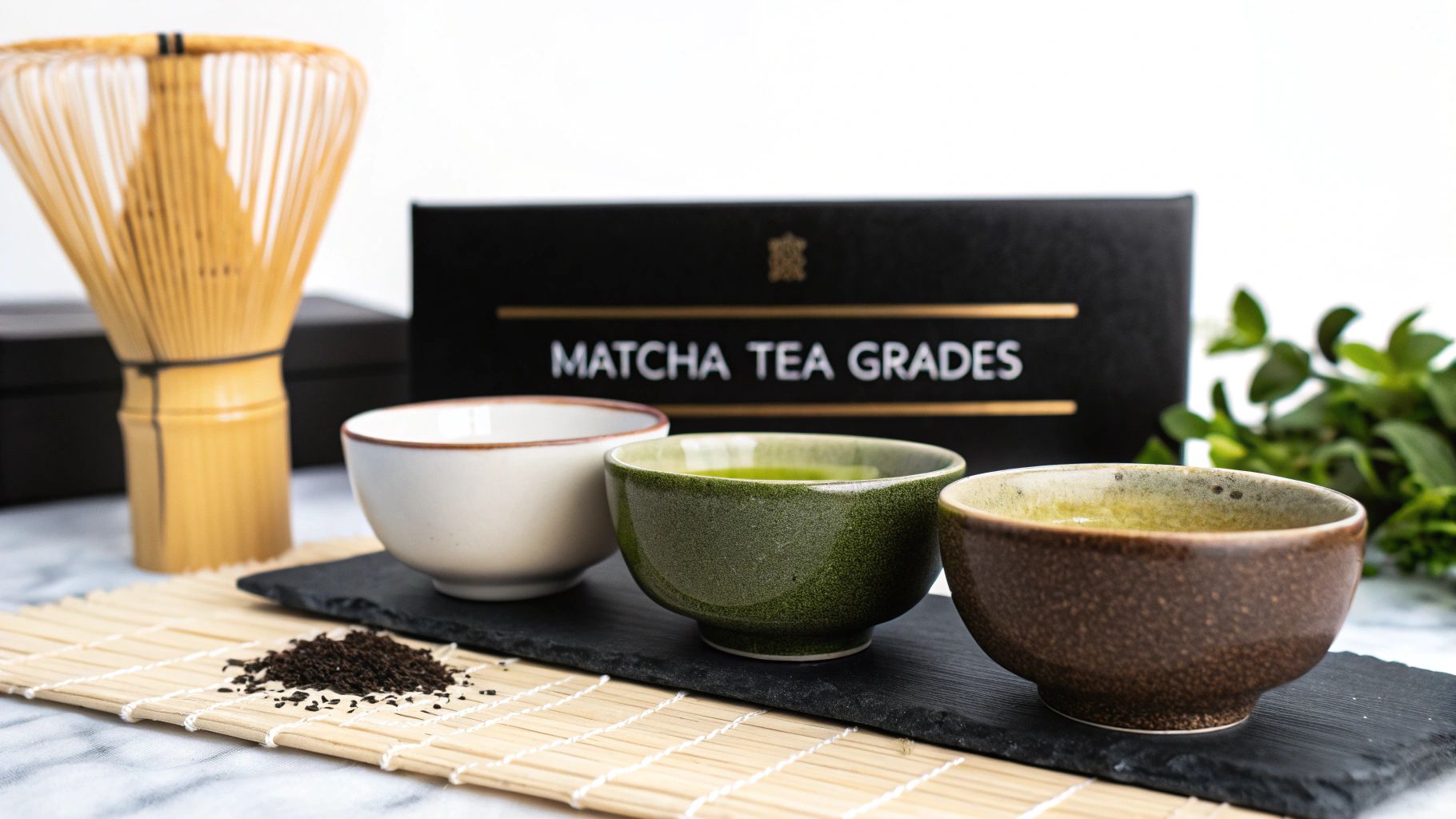
Explore our guide to matcha tea grades, from ceremonial to culinary. Understand the key differences to choose the right matcha for your daily ritual.
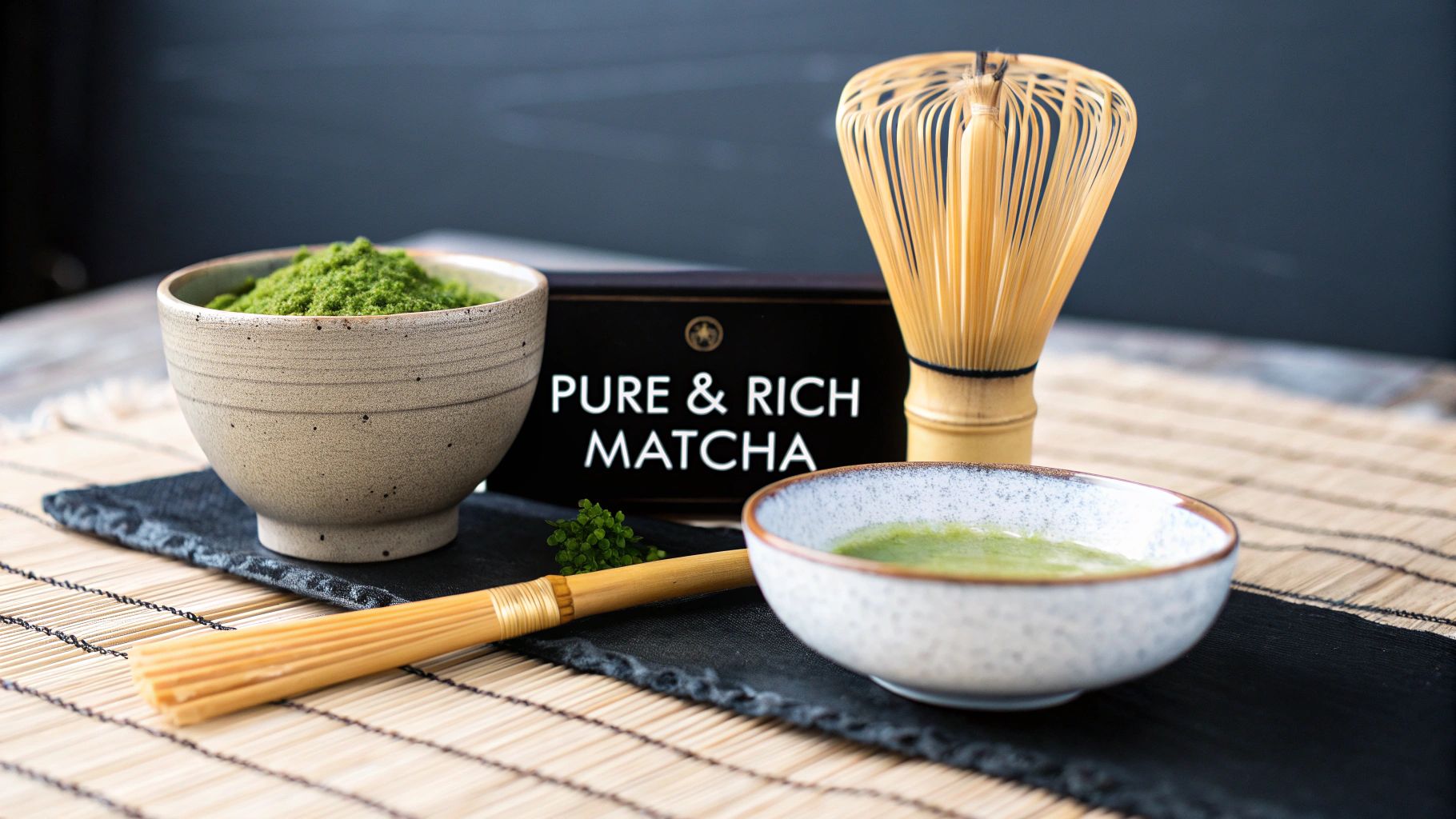
Explore ceremonial organic matcha's health benefits, history, and brewing tips. Elevate your daily ritual with the purest ceremonial matcha today!
